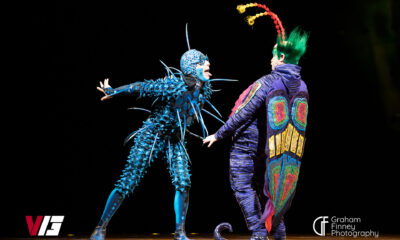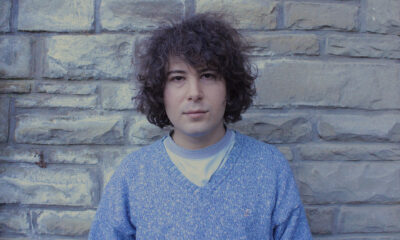Reviews
The Third Man (#090)
“100 Films for 100 Rainy Days”

Directed by: Carol Reed» Written by: Graham Greene, 1949 » Region/Time: U.K., black & white, 104 minutes
Starring: Joseph Cotten as Holly Martins » Alida Valli as Anna Schmidt » Trevor Howard as Major Calloway » Bernard Lee as Sergeant Paine » Paul Hörbiger as Harry’s Porter » Ernst Deutsch as ‘Baron’ Kurtz » Siegfried Breuer as Popescu » Erich Ponto as Dr. Winkel » Orson Welles as Harry Lime.

“I never knew the old Vienna before the war…”
What a difference a war makes. 1949’s The Third Man, scripted by British author and occasional spy Graham Greene, is in many ways a dark reflection of 1942’s Casablanca. Both tell a tale of the hero and his rival for the affection of a woman torn between the two. The Third Man, however, takes place in the real streets of 1949 Vienna, bombed out by Allied aircraft, occupied by French, Russian, British and American troops. The music seems jaunty and upbeat, but there is a lack of joy. Characters speak a hodgepodge of languages and struggle to understand and be understood. Holly Martins, American writer of western novels, only speaks English, of course, and so none of the other languages are subtitled for the audience. We share in his confusion as he turns up in Vienna at the invite of an old friend, only to find out that he has recently been killed in a very suspicious accident.

Holly Martin’s investigation into Harry Lime’s death uncovers a menacing cabal of Austrians, Baron Kurtz, Dr. Winkel (“VIN-kel”) and Popescu, who are clearly lying to him and intimidating the witnesses, including the porter who claims there was a third man at the accident. Holly also discovers the British police major, Calloway, believes Harry to have been a hardened criminal. In his hunt for the murderers and on a mission to redeem his friend’s good name, he falls in love with Harry’s mistress, Anna. In the final third of the film, everything is revealed – the third man, Harry Lime’s true nature, Anna’s choice in lovers, Holly’s true friendship and Harry’s ultimate fate.

The final section contains some of the best sequences ever put on film: the reveal of the third man (one of the greatest entrances in cinema history), the ferris wheel sequence (opening a door was never so menacing) and the much imitated chase through the sewers (the fingertips reaching through the sewer gate are the director’s own). Keen viewers will note that the final funeral sequence bears an uncanny resemblance to the final sequence in The Departed.
Like Casablanca, The Third Man is a happy accident of combined talents working at their peak: Joseph Cotton, as Holly Martins, puts in one of his greatest performances and brought his friend and Citizen Kane co-star, Orson Welles to the movie; Graham Greene and director Carol Reed had already completed two exceptional pictures together which I highly recommend – Odd Man Out (1947) and The Fallen Idol (1948); and Anton Karas’ musical score for the zither went on to become one of the biggest hits of the time. Reed, highly influenced by Welles’ earlier techniques on Citizen Kane, The Stranger and Lady From Shanghai, keeps the cobblestones wet, the camera almost constantly tilted and the shadows exaggerated, all to great effect. It is a miracle that Carol Reed managed to keep David O. Selznick’s hands off of this movie, in which he wanted to have Noel Coward star with a “happy” ending.

What catapults this film from excellence to compulsory viewing is Welles’ relatively brief performance as Harry Lime. He became so well known for this film that The Third Man Theme would be played whenever he showed up on talk shows. He once said Harry Lime was the greatest “star part” there was, a “star part” being the person everyone talks about in a film before he actually turns up (e.g. Keyser Soze in The Usual Suspects). The speech Harry Lime makes, in partial justification of his actions, was supposedly written by Orson himself and perfectly summarizes The Third Man’s rendering of corrupt and disillusioned postwar Europe:
“You know what the fellow said: In Italy for thirty years under the Borgias they had warfare, terror, murder and bloodshed, but they produced Michelangelo, Leonardo da Vinci and the Renaissance. In Switzerland they had brotherly love—they had 500 years of democracy and peace, and what did that produce? The cuckoo clock.”

Up Next in the Film Canon: A jewellery heist and some homoerotic undertones.
-

 Alternative/Rock15 hours ago
Alternative/Rock15 hours agoThe V13 Fix #010 w/ High on Fire, NOFX, My Dying Bride and more
-

 Hardcore/Punk1 week ago
Hardcore/Punk1 week agoHastings Beat Punks Kid Kapichi Vent Their Frustrations at Leeds Beckett University [Photos]
-

 Culture1 week ago
Culture1 week agoCirque Du Soleil OVO Takes Leeds Fans on a Unique, Unforgettable Journey [Photos]
-

 Alternative/Rock6 days ago
Alternative/Rock6 days agoA Rejuvenated Dream State are ‘Still Dreaming’ as They Bounce Into Manchester YES [Photos]
-

 Music2 days ago
Music2 days agoReclusive Producer Stumbleine Premieres Beat-Driven New Single “Cinderhaze”
-

 Culture2 days ago
Culture2 days agoDan Carter & George Miller Chat Foodinati Live, Heavy Metal Charities and Pre-Gig Meals
-

 Indie1 week ago
Indie1 week agoMichele Ducci Premieres Bouncy New Single “You Lay the Path by Walking on it”
-

 Alternative/Rock1 week ago
Alternative/Rock1 week agoWilliam Edward Thompson Premieres His Stripped-Down “Sleep Test” Music Video




